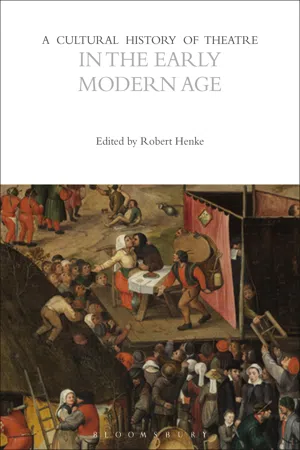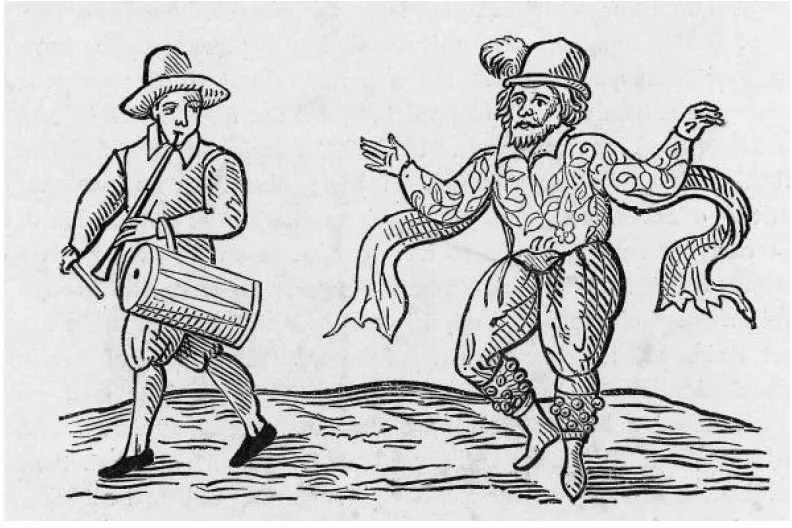![]()
CHAPTER ONE
Institutional Frameworks for Theatre, 1400–1650
Mapping Theatrical Resources
TOM BISHOP AND ROBERT HENKE
As with the histories of most complex cultural phenomena, no single or linear narrative adequately charts the institutional frameworks regulating, ideologically forming, and financially supporting theatre and performance from 1400 to 1650 in Europe. This is especially the case if one considers the matter transnationally, and even beyond the four most prominent early modern theatres of England, Spain, France and Italy. The patchwork of institutions and the temporality of change were uneven, and the most secure generalization that can be made is that institutional frameworks underwriting theatre and performance in this period were socially and economically hybrid, reflecting the age’s uneven transition from feudal to capitalist modes of production and organization. Complicating the situation even more is the fact that paratheatrical and diverse performative practices (whether perceived as involving ‘performance’ or not) positively thrived in a period when increased urban growth and the rise of the courts both generated conspicuous public stages. The age abounds with myriad forms of street and piazza theatre, carnival, charivari, public executions, public shaming rituals, royal entries, urban pageants, succession ceremonies, and much, much more. In considering early modern forms of theatre and performance, cultural history in the Marxist tradition of Gramsci and Raymond Williams can closely attend to economic ‘substructure’ while also acknowledging the independent agency and mobility of cultural forces.1 An understanding of the larger currents of political and economic change can clarify some of the parameters of artistic production, and also illuminate the social ‘structures of feeling’ that, in Williams’s view, constitute culture.2 Residual and emergent, as well as dominant cultural ideas, postures, attitudes and assumptions should be examined in order to gain as full a picture as possible.
Between 1400 and 1650, broadly speaking, developments in economic and political realms pulled in contrary but dialectically related directions. On the one hand, a generally freer circulation of money, commodities, labour and land compounded a fraying of tighter feudal relations with the emergence and expansion of mercantile commercialism and capitalist modes of production in European towns and cities.3 Urban corporations and those who controlled them sought and increasingly gained a measure of independence from local feudal lords and seigneurs. Their success in these endeavours underwrote the creation of a Europe-wide network of increasingly wealthy traders, merchants and bankers, and tapped at large into national and international networks of trade and, especially in the case of extra-European activity, plunder. It is out of this widening network that the central economic drivers and institutions of the future – industrialization, the corporation and the bank – appear at the end of our period. On the other hand, such wrenching conflicts as the Wars of the Roses, the Castilian and Catalonian Civil Wars and the Conquest of Granada, and the Hundred Years’ War eventually enabled and resulted in a drive to consolidate political and military power under strong national or imperial leaders: Henry VII in England, Ferdinand and Isabella in Spain, Louis XI in France, Maximilian I in the Holy Roman Empire. The rule of these monarchs was increasingly conceived and expressed in ‘absolutist’ terms, as the king or emperor or duke became in effect a transferred and enlarged ‘apparatus of feudal domination’ whose chief task was to suborn or dominate the remnants of feudalism itself.4
Capitalism and absolutism thus grew up together, but were also checked and limited in various ways, including by each other. Emergent capitalism was retarded in its drive to value extraction and market efficiency by the persistence of feudal habits of organization and production, particularly in outlying and remoter areas, and by its need to rely on monarchical power, for instance for the protection afforded by monopolies and military force. Absolutism, meanwhile, was checked both by ongoing struggle against surviving feudal magnates in times of weakness (as during the Fronde in France), and by its recurrent need to rely directly on the financial backing of capital to fight its wars and promulgate its glories.5 In the longer view, Perry Anderson argues, absolutism was a transitional structure – though it cannot, of course, have seemed like one at the time – which sought to absorb from the feudal aristocracy its local jurisdiction in law and violence, but it was shot through with contradic-tions at every point, most especially in its ever-increasing dependence on capital markets, and never more clearly than in the case of Habsburg Philip II’s eventually disastrous imperial overreach in both the New World and in northern and central Europe.
The implications of these large-scale pressures and changes for theatrical activity across Europe are sketched below. In broad terms, we argue, the parallel growth of absolutist patronage and expanded urban markets drove innovation in theatrical institutions. The claim that theatrical and theatre-supporting institutions were particularly tied, even in their non-homogeneity, to larger economic and social patterns of organization, depends in turn upon recognizing theatre as a cultural form that requires a concentration of material, temporal and human resources that some other forms comparatively do not. Though substantial training may be required to become a poet, and substantial patronage of one kind or another to sustain poetry as a livelihood, the corresponding requirements for theatrical enterprise are, for the most part, even more exigent. Local and punctuated theatrical activity, of the kind tied, say, to a calendrical cycle, may be able to survive, and even flourish, on the intermittent commitment of available resources by patrons or community. The largest and most important theatrical development of the period in question, however – the emergence of regular, secular, commercial, urban and professional playing that could provide sustained presentation and livelihood – depended on fundamental changes in the concentration, organization and flow of resources across societies as a whole that were deeply related to the entwined emergence of capitalism and absolutism. These changes made possible new ways of directing resources to theatre, and new reasons for doing so, even while older ways persisted, sometimes right alongside and even within the new.
To clarify these relations, we offer a systematic taxonomy or ‘map’ that may provide general orientation on how and when and with what concentrations of resources theatrical activity was organized across the period at large. Diachronic changes can, in this way, be observed in relation to a large matrix that continues to register areas where change lags. This is important since many cultural and social practices that continued to inform early modern modes of performance and reception were of longue durée, extending on both sides of the period in question, even though one can observe a broad transformative shift from festival-based occasional theatre to more or less quotidian professional theatre primarily based on the market and drawing resources and strategies from emergent capitalist modes of production and absolutist lines of patronage.
For the purposes of this taxonomy then, we identify two intersecting axes along which to locate theatrical activity. One axis charts the level of resources in material, time, remuneration and other support, from low to high, exiguous to lavish. The other axis charts the continuity of resource support that potential performers have access to, from strictly limited in time to an access regular enough to function as sustaining (Figure 1.1).
FIGURE 1.1: Map of theatrical resources.
I
In one corner of the resulting ‘map’ (lower left) are the various performances with access to resources both poor and discontinuous. Where access is constrained by geography or lack of mobility in an area that cannot or will not generate continuous support even at a low level, sustained livelihood activity for theatre is impossible. But this does not mean there is no performance. Here we find such theatrical enterprises as rural mummings, folk plays, and other performances associated with religious rites or other festivals, drawing on local skills and aptitudes and in general mobilized from the ordinary surrounding world of work (Figure 1.2).
This small-scale but almost ubiquitous and highly durable institutional framework both pre-dates and post-dates our period. Everywhere longstanding village folk dramas treating heroes such as Robin Hood, hero combats, wooing, gender reversals, the battle between winter and summer or between Lent and Carnival, and issues or rituals of fertility were keyed to important annual festivals or local observances. In England, principal occasions included Christmas, Epiphany, Shrove Tuesday/Carnival, Hock Tuesday, Easter, Plough Monday, Pentecost, May Day, Midsummer Watch and All Souls. The community festivities of such days created a sense of cohesiveness and connection with the past, and possibly helped to mediate between local feudal lords and peasantry. Though partly threatened by the retreat of feudalism and partly frowned on by religious reformist zeal for their patent, if often tempered, pagan elements, these performances survived long and late, and increasingly catered to an emerging early modern nostalgia for a feudal past.
The Church remained the chief institutional sponsor of these activities, which were often produced by groups of villagers organized somewhat like a guild. They provided an income source – a form of charity – for churches, even after they had first paid off the amateur performers themselves. Whereas England tended to bifurcate its festivity between the indoor games and entertainments of the Christmas season and the outdoor entertainments focused around May Day, Corpus Christi Day, and Midsummer, the warmer countries of southern Europe made the earlier Carnival period itself – and especially the few days culminating in Mardi Gras – the time of intense outdoor theatrical activity. In the countryside of Italy and other continental countries, carnival plays, produced by churches and townspeople in the manner of the English village plays, often involved the figure of Carnival himself being tried, convicted, reading his last will and testament, then executed, and lamented.
FIGURE 1.2: Woodcut of Elizabethan clown Will Kemp (1560–1603), dressed as a traditional morris dancer. From Kemp’s Nine Day’s Wonder (1600). (Photo by Time Life Pictures/Mansell/The LIFE Images Collection/Getty Images.)
Such traditional forms of folk performance do not get frequent mention in early modern theatre histories (except in regard to Shakespeare). However, from a cultural historical perspective that asks, across the socio-economic spectrum, (1) who made theatre, (2) how it mattered to the people who produced and consumed it, and (3) how emergent forms of theatre in the period were put together, such traditional forms are fundamental.
II
Discontinuous, intermittent or irregular performance at the high end of the resource axis (upper left) is already well established at the beginning of our period. Large civic and religious institutions had been sponsoring occasional or festival drama on a lavish scale for a considerable time. Liturgical drama in monasteries, civic presentations of Passion plays and Corpus Christi cycles and large-scale carnival theatricalities in both urban and rural areas show sponsorshi...


